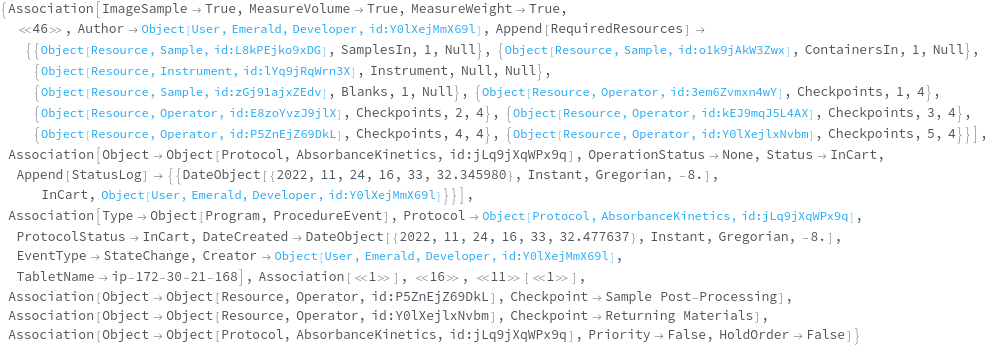ExperimentAbsorbanceKinetics
ExperimentAbsorbanceKinetics[Samples]⟹Protocol
generates a Protocol for measuring absorbance of the provided Samples over a period of time.
Absorbance kinetics studies how samples absorb ultraviolet and visible light radiation over time. Samples are exposed to light at a range of wavelengths, and the absorbance is measured by determining how much light at is transmitted through the sample across all these wavelengths. Because samples can be injected into the read plate at a specified time, the change of this absorbance over time can be used to monitor reactions and observe the kinetics of the interactions (say binding or dissociation) between substances.
Experimental Principles

Figure 1.1: Step 1: Samples are prepared in a reader-compatible shallow well plate. Step 2: Injection lines are cleaned and primed. Step 3: The assay plate is optionally held at a specified temperature. Step 4: Injection samples are dispensed into the assay plate. Step 5: The assay plate is shaken. Step 6: Absorbance is read over a period of time. Step 7: Optionally, data may be assessed with AnalyzeKinetics to fit rate constants to the reactions.
Instrumentation
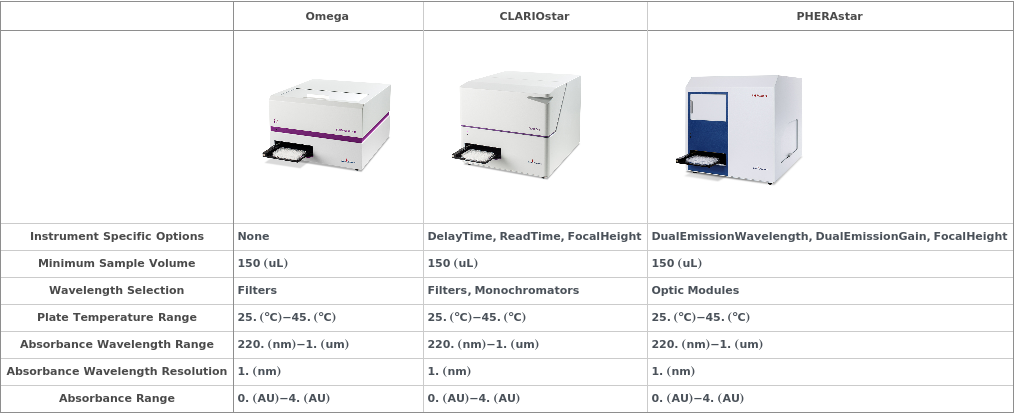
FLUOstar Omega


Figure 2.1.1: In the Omega, a Xenon Flash Lamp sends photons through each well of the plate. The light that is not absorbed is then directed through a prism which splits the beam into wavelengths from 220 nm to 1000 nm that are measured by the detector.
The plate chamber can be heated up to 45°C and it can mix the plate at up to 700 RPM before the run.
The reader has two 300μL syringe pump injectors which can be used for 0.5 - 300 μL injections of two unique samples prior to the run.
CLARIOstar

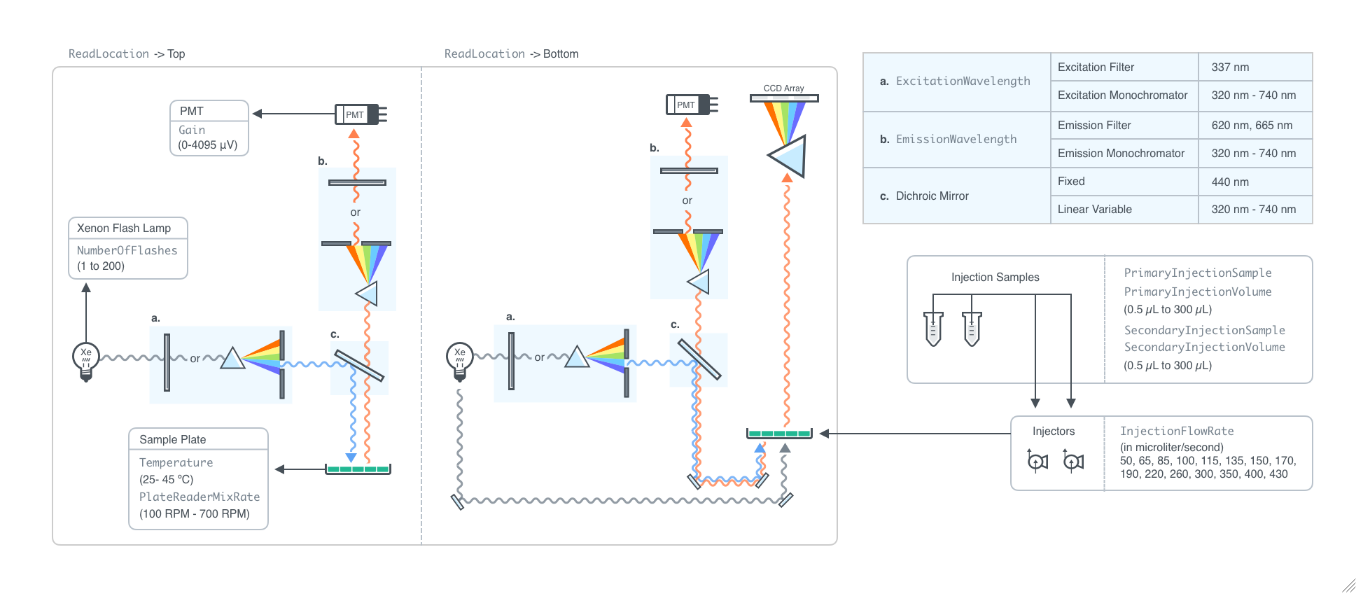
Figure 2.2.1: In the CLARIOstar, a Xenon Flash Lamp sends photons through each well of the plate. The light that is not absorbed is then directed through a prism which splits the beam into wavelengths from 220 nm to 1000 nm that are measured by the detector.
The plate chamber can be heated up to 45°C and it can mix the plate at up to 700 RPM before the run.
The reader has two 300μL syringe pump injectors which can be used for 0.5 - 300 μL injections of two unique samples prior to the run.
PHERAstar FS

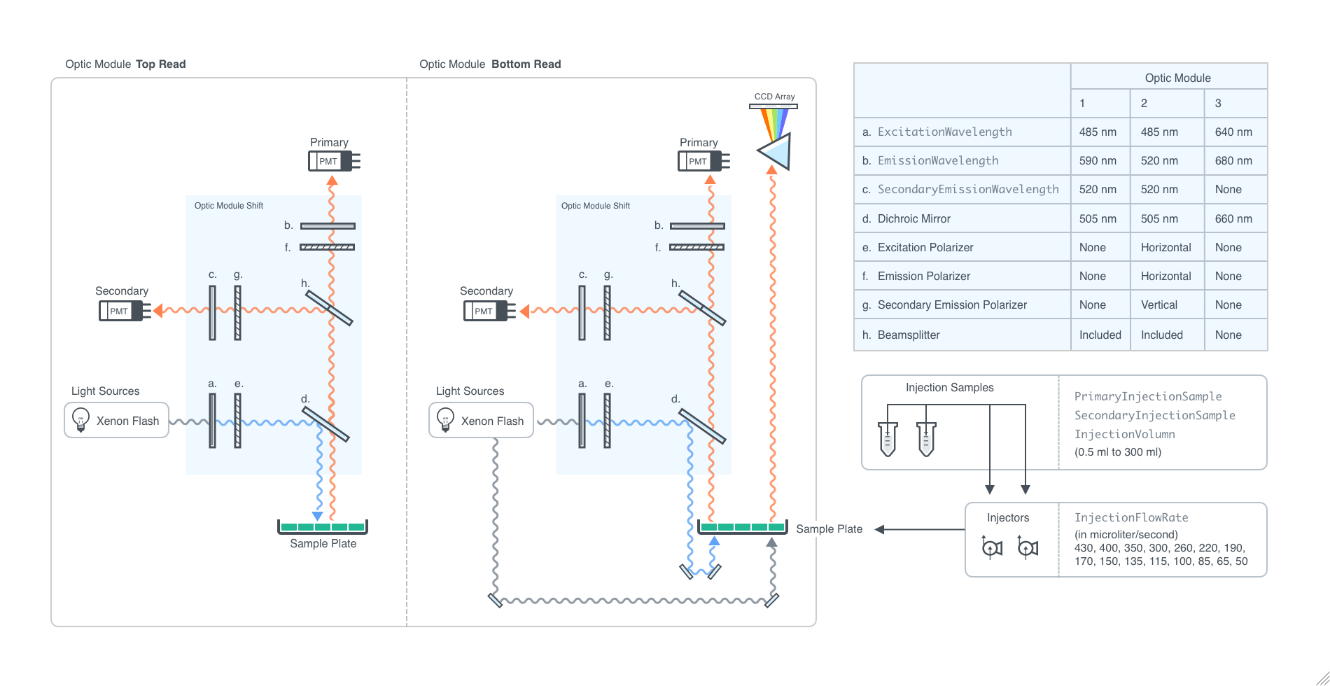
Figure 2.3.1: In the PHERAstar, a Xenon Flash Lamp sends photons through each well of the plate. The light that is not absorbed is then directed through a prism which splits the beam into wavelengths from 220 nm to 1000 nm that are measured by the detector.
The plate chamber can be heated up to 45°C and it can mix the plate at up to 700 RPM before the run.
The reader has two 300μL syringe pump injectors which can be used for 0.5 - 300 μL injections of two unique samples prior to the run.
Experiment Options
General
Instrument
Default Calculation: Resolves to the instrument capable of performing the requested sampling. If any instrument can be used, resolves to use the model with the most available instruments in the lab.
Pattern Description: An object of type or subtype Model[Instrument, PlateReader] or Object[Instrument, PlateReader]
Programmatic Pattern: ObjectP[{Model[Instrument, PlateReader], Object[Instrument, PlateReader]}] | Automatic
Preparation
Indicates if this unit operation is carried out primarily robotically or manually. Manual unit operations are executed by a laboratory operator and robotic unit operations are executed by a liquid handling work cell.
WorkCell
NumberOfReplicates
The number of times to repeat absorbance reading on each provided sample. If Aliquot -> True, this also indicates the number of times each provided sample will be aliquoted. Note that when using the Lunatic, this indicates the number of independent times a 2 uL aliquot will be put into the Lunatic chips and read, and when using the BMG plate readers, this indicates the number of aliquots of the same sample that will be read.
Default Calculation: When using the BMG plate readers, automatically set to 3 if QuantifyConcentration is True for any experiment sample. When using the Lunatic, automatically set to 3 or 2 depending on the total number of the experiment samples and the blank samples if QuantifyConcentration is True. The total number of samples allowed in one Lunatic run is 94. Otherwise automatically set to Null.
Sample Handling
PlateReaderMixSchedule
Indicates the points at which mixing should occur in the plate reader, for instance after every set of injections.
Default Calculation: Automatically set to AfterInjections when other mix options are set and injections are specified or to BetweenReadings when mixing is specified but there are no injections.
Temperature
Indicates the temperature the samples will held at prior to measuring absorbance and during data acquisition within the instrument.
Default Calculation: Sets to Ambient if an instrument is capable of manipulating the temperature of the samples.
Pattern Description: Ambient or greater than or equal to 25 degrees Celsius and less than or equal to 45 degrees Celsius.
EquilibrationTime
The length of time for which the samples equilibrate at the requested temperature before being read.
Default Calculation: If an instrument is capable setting the temperature of the samples, sets to 0 second when Temperature is set to Ambient. Otherwise, it is set to 5 minutes.
PlateReaderMix
PlateReaderMixTime
Default Calculation: Automatically set to 30 second if any other plate reader mix options are specified.
PlateReaderMixRate
Default Calculation: Automatically set to 700 RPM if any other plate reader mix options are specified.
Pattern Description: Greater than or equal to 100 revolutions per minute and less than or equal to 700 revolutions per minute or Null.
PlateReaderMixMode
Default Calculation: Automatically set to DoubleOrbital if any other plate reader mix options are specified.
MoatSize
Indicates the number of concentric perimeters of wells to fill with MoatBuffer in order to slow evaporation of inner assay samples.
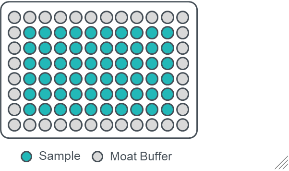
Figure 3.1: Use the moat options, MoatBuffer, MoatVolume and MoatSize to create an outer ring of wells filled with buffer. This has been shown to decrease evaporation during long reads.
MoatVolume
Default Calculation: Automatically set to the RecommendedFillVolume of the assay plate if informed, or 75% of the MaxVolume of the assay plate if not, if any other moat options are specified.
Pattern Description: Greater than or equal to 1 microliter and less than or equal to 300 microliters or Null.
MoatBuffer
Pattern Description: An object of type or subtype Object[Sample] or Model[Sample] or a prepared sample or Null.
RetainCover
Indicates if the plate seal or lid on the assay container should not be taken off during measurement to decrease evaporation. When this option is set to True, injections cannot be performed as it's not possible to inject samples through the cover. When using the Cuvette Method, automatically set to True.
TertiaryInjectionFlowRate
The speed at which to transfer injection samples into the assay plate in the third round of injections.
Pattern Description: 430 microliters per second, 400 microliters per second, 350 microliters per second, 300 microliters per second, 260 microliters per second, 220 microliters per second, 190 microliters per second, 170 microliters per second, 150 microliters per second, 135 microliters per second, 115 microliters per second, 100 microliters per second, 85 microliters per second, 65 microliters per second, or 50 microliters per second or Null.
QuaternaryInjectionFlowRate
The speed at which to transfer injection samples into the assay plate in the fourth round of injections.
Pattern Description: 430 microliters per second, 400 microliters per second, 350 microliters per second, 300 microliters per second, 260 microliters per second, 220 microliters per second, 190 microliters per second, 170 microliters per second, 150 microliters per second, 135 microliters per second, 115 microliters per second, 100 microliters per second, 85 microliters per second, 65 microliters per second, or 50 microliters per second or Null.
Absorbance Measurement
NumberOfReadings
Number of redundant readings taken by the detector to determine a single averaged absorbance reading.
Default Calculation: If an instrument capable of adjusting NumberOfReadings is selected, resolves to 100. Otherwise resolves to Null
ReadDirection
Indicate the plate path the instrument will follow as it measures absorbance in each well, for instance reading all wells in a row before continuing on to the next row (Row).
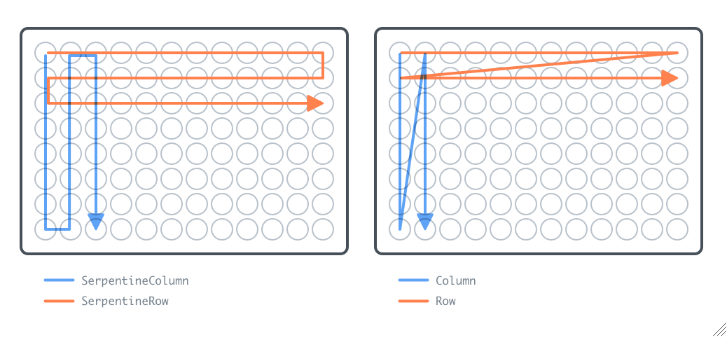
Figure 3.2: Use the ReadDirection option to control how the plate reader scans the plate during each read cycle. Choosing a more efficient path will lead to a shorter DetectionInterval. Also note that you may want to consider dripping injectors if you're working with low viscosity injection samples.
Default Calculation: Resolves to Row if a plate reader capable of adjusting read direction is selected.
RunTime
ReadOrder
Indicates if all measurements and injections are done for one well before advancing to the next (Serial) or in cycles in which each well is read once per cycle (Parallel).
Wavelength
The wavelength(s) at which absorbance is measured. All indicates that the full spectrum available to the plate reader is used.
Default Calculation: Automatically resolves to the wavelengths specified in the input samples' ExtinctionCoefficients field or 260 Nanometer if that field is not populated, for Serial ReadOrder or Matrix SamplingPattern. Otherwise automatically resolves to All.
Pattern Description: All or a span from anything greater than or equal to 220 nanometers and less than or equal to 1000 nanometers to anything greater than or equal to 220 nanometers and less than or equal to 1000 nanometers or greater than or equal to 220 nanometers and less than or equal to 1000 nanometers or list of one or more greater than or equal to 220 nanometers and less than or equal to 1000 nanometers entries.
Programmatic Pattern: (All | RangeP[220*Nanometer, 1000*Nanometer] | {RangeP[220*Nanometer, 1000*Nanometer]..} | RangeP[220*Nanometer, 1000*Nanometer] ;; RangeP[220*Nanometer, 1000*Nanometer]) | Automatic
Injections
PrimaryInjectionSample
The sample to be injected in the first round of injections in order to introduce a time sensitive reagent/sample into the plate before/during absorbance measurement. The corresponding injection times and volumes can be set with PrimaryInjectionTime and PrimaryInjectionVolume.
Pattern Description: An object of type or subtype Object[Sample] or Model[Sample] or a prepared sample or Null.
PrimaryInjectionVolume
Pattern Description: Greater than or equal to 0.5 microliters and less than or equal to 300 microliters or Null.
SecondaryInjectionSample
The sample to be injected in the second round of injections. Set the corresponding injection times and volumes with SecondaryInjectionTime and SecondaryInjectionVolume.
Pattern Description: An object of type or subtype Object[Sample] or Model[Sample] or a prepared sample or Null.
SecondaryInjectionVolume
Pattern Description: Greater than or equal to 0.5 microliters and less than or equal to 300 microliters or Null.
PrimaryInjectionFlowRate
The speed at which to transfer injection samples into the assay plate in the first round of injections.
Pattern Description: 430 microliters per second, 400 microliters per second, 350 microliters per second, 300 microliters per second, 260 microliters per second, 220 microliters per second, 190 microliters per second, 170 microliters per second, 150 microliters per second, 135 microliters per second, 115 microliters per second, 100 microliters per second, 85 microliters per second, 65 microliters per second, or 50 microliters per second or Null.
SecondaryInjectionFlowRate
The speed at which to transfer injection samples into the assay plate in the second round of injections.
Pattern Description: 430 microliters per second, 400 microliters per second, 350 microliters per second, 300 microliters per second, 260 microliters per second, 220 microliters per second, 190 microliters per second, 170 microliters per second, 150 microliters per second, 135 microliters per second, 115 microliters per second, 100 microliters per second, 85 microliters per second, 65 microliters per second, or 50 microliters per second or Null.
InjectionSampleStorageCondition
The non-default conditions under which any injection samples used by this experiment are stored after the protocol is completed.
Pattern Description: {AmbientStorage, Refrigerator, Freezer, DeepFreezer, CryogenicStorage, YeastIncubation, BacteriaIncubation, MammalianIncubation, TissueCultureCellsIncubation, MicrobialCellsIncubation, MicrobialCellsShakingIncubation, YeastCellsIncubation, YeastCellsShakingIncubation, ViralIncubation, AcceleratedTesting, IntermediateTesting, LongTermTesting, UVVisLightTesting} or Disposal or Null.
TertiaryInjectionSample
The sample to be injected in the third round of injections. Note that only two unique samples can be injected in total. The corresponding injection times and volumes can be set with TertiaryInjectionTime and TertiaryInjectionVolume.
Pattern Description: An object of type or subtype Object[Sample] or Model[Sample] or a prepared sample or Null.
TertiaryInjectionVolume
Pattern Description: Greater than or equal to 0.5 microliters and less than or equal to 300 microliters or Null.
QuaternaryInjectionSample
The sample to be injected in the fourth round of injections. Note that only two unique samples can be injected in total. The corresponding injection times and volumes can be set with QuaternaryInjectionTime and QuaternaryInjectionVolume.
Pattern Description: An object of type or subtype Object[Sample] or Model[Sample] or a prepared sample or Null.
QuaternaryInjectionVolume
Pattern Description: Greater than or equal to 0.5 microliters and less than or equal to 300 microliters or Null.
PrimaryInjectionTime
SecondaryInjectionTime
TertiaryInjectionTime
QuaternaryInjectionTime
Data Processing
BlankAbsorbance
For each members of SamplesIn, indicates if a corresponding blank measurement, which consists of a separate container (well, chamber, or cuvette) than SampleLink, will be performed, prior to measuring the absorbance of samples. If using Cuvettes, the BlankAbsorbance will be read at the same time as the SampleLink.
Blanks
The object or source used to generate a blank sample (i.e. buffer only, water only, etc.) whose absorbance is subtracted as background from the absorbance readings of the SamplesIn to take accound for any artifacts.
Default Calculation: Automatically set to Null if BlankMeasurement is False. Otherwise, automatically set to the value of Solvent in SamplesIn. If Solvent not specfied, set to Model[Sample, "Milli-Q water"].
Pattern Description: An object of type or subtype Model[Sample] or Object[Sample] or a prepared sample or Null.
BlankVolumes
The amount of liquid of the Blank that should be transferred out and used to blank measurements. Set BlankVolume to Null to indicate blanks should be read inside their current containers.
Default Calculation: If BlankMeasurement is True, automatically set to the value of AssayVolume if that was specified, or maximum volume of the container otherwise.
Pattern Description: Greater than or equal to 1 microliter and less than or equal to 4000 microliters or Null.
Sampling
SamplingDistance
Default Calculation: Automatically resolves to Null if SamplingPattern is set to Center otherwise resolves to 80% of the diameter of the well.
Pattern Description: Greater than or equal to 1 millimeter and less than or equal to 6 millimeters or Null.
SamplingDimension
Specifies the size of the grid used for Matrix sampling. For example SamplingDimension->5 will scan a 5 x 5 grid.
SamplingPattern

Figure 3.3: Ring sampling allows multiple measurements over a band with a specified diameter. The specified number of flashes will be equally divided over the ring and a higher number will yield to increased sampling (as seen in A). The average value of all measurements will be returned as a single data point. Spiral sampling follows the same principle as ring sampling, but covers a larger part of the well as it takes spiraling inward measurements. Again the number of flashes determines if the well is highly sampled (A) or lightly (B). Use Matrix sampling to scan over a NxN grid of points. Note that points on the border of the well will not be measured.
Default Calculation: When using the BMG plate readers, automatically set to Matrix if SamplingDimension is specified or Ring if SamplingDistance is specified. Otherwise set to Center.
Post Experiment
SamplesInStorageCondition
The non-default conditions under which the SamplesIn of this experiment should be stored after the protocol is completed. If left unset, SamplesIn will be stored according to their current StorageCondition.
Pattern Description: {AmbientStorage, Refrigerator, Freezer, DeepFreezer, CryogenicStorage, YeastIncubation, BacteriaIncubation, MammalianIncubation, TissueCultureCellsIncubation, MicrobialCellsIncubation, MicrobialCellsShakingIncubation, YeastCellsIncubation, YeastCellsShakingIncubation, ViralIncubation, AcceleratedTesting, IntermediateTesting, LongTermTesting, UVVisLightTesting} or Disposal or Null.
Sample Prep Options
Sample Preparation
PreparatoryUnitOperations
Specifies a sequence of transferring, aliquoting, consolidating, or mixing of new or existing samples before the main experiment. These prepared samples can be used in the main experiment by referencing their defined name. For more information, please reference the documentation for ExperimentSampleManipulation.
Pattern Description: List of one or more unit Operation ManualSamplePreparation or RoboticSamplePreparation or unit Operation must match SamplePreparationP entries or Null.
Programmatic Pattern: {((ManualSamplePreparationMethodP | RoboticSamplePreparationMethodP) | SamplePreparationP)..} | Null
PreparatoryPrimitives
Specifies a sequence of transferring, aliquoting, consolidating, or mixing of new or existing samples before the main experiment. These prepared samples can be used in the main experiment by referencing their defined name. For more information, please reference the documentation for ExperimentSampleManipulation.
Pattern Description: List of one or more a primitive with head Define, Transfer, Mix, Aliquot, Consolidation, FillToVolume, Incubate, Filter, Wait, Centrifuge, or Resuspend entries or Null.
Preparatory Incubation
Incubate
Indicates if the SamplesIn should be incubated at a fixed temperature prior to starting the experiment or any aliquoting. Sample Preparation occurs in the order of Incubation, Centrifugation, Filtration, and then Aliquoting (if specified).
Default Calculation: Resolves to True if any of the corresponding Incubation options are set. Otherwise, resolves to False.
IncubationTemperature
Temperature at which the SamplesIn should be incubated for the duration of the IncubationTime prior to starting the experiment.
Pattern Description: Ambient or greater than or equal to -20 degrees Celsius and less than or equal to 500 degrees Celsius or Null.
Programmatic Pattern: ((Ambient | RangeP[$MinIncubationTemperature, $MaxIncubationTemperature]) | Automatic) | Null
IncubationTime
Duration for which SamplesIn should be incubated at the IncubationTemperature, prior to starting the experiment.
Mix
Default Calculation: Automatically resolves to True if any Mix related options are set. Otherwise, resolves to False.
MixType
Default Calculation: Automatically resolves based on the container of the sample and the Mix option.
Pattern Description: Roll, Vortex, Sonicate, Pipette, Invert, Stir, Shake, Homogenize, Swirl, Disrupt, or Nutate or Null.
MixUntilDissolved
Indicates if the mix should be continued up to the MaxIncubationTime or MaxNumberOfMixes (chosen according to the mix Type), in an attempt dissolve any solute. Any mixing/incubation will occur prior to starting the experiment.
Default Calculation: Automatically resolves to True if MaxIncubationTime or MaxNumberOfMixes is set.
MaxIncubationTime
Maximum duration of time for which the samples will be mixed while incubated in an attempt to dissolve any solute, if the MixUntilDissolved option is chosen. This occurs prior to starting the experiment.
Default Calculation: Automatically resolves based on MixType, MixUntilDissolved, and the container of the given sample.
IncubationInstrument
Default Calculation: Automatically resolves based on the options Mix, Temperature, MixType and container of the sample.
Pattern Description: An object of type or subtype Model[Instrument, Roller], Model[Instrument, OverheadStirrer], Model[Instrument, Vortex], Model[Instrument, Shaker], Model[Instrument, BottleRoller], Model[Instrument, Roller], Model[Instrument, Sonicator], Model[Instrument, HeatBlock], Model[Instrument, Homogenizer], Model[Instrument, Disruptor], Model[Instrument, Nutator], Model[Instrument, Thermocycler], Model[Instrument, EnvironmentalChamber], Model[Instrument, Pipette], Object[Instrument, Roller], Object[Instrument, OverheadStirrer], Object[Instrument, Vortex], Object[Instrument, Shaker], Object[Instrument, BottleRoller], Object[Instrument, Roller], Object[Instrument, Sonicator], Object[Instrument, HeatBlock], Object[Instrument, Homogenizer], Object[Instrument, Disruptor], Object[Instrument, Nutator], Object[Instrument, Thermocycler], Object[Instrument, EnvironmentalChamber], or Object[Instrument, Pipette] or Null.
AnnealingTime
Minimum duration for which the SamplesIn should remain in the incubator allowing the system to settle to room temperature after the IncubationTime has passed but prior to starting the experiment.
IncubateAliquotContainer
The desired type of container that should be used to prepare and house the incubation samples which should be used in lieu of the SamplesIn for the experiment.
Programmatic Pattern: ((ObjectP[Model[Container]] | {GreaterEqualP[1, 1] | (Automatic | Null), (ObjectP[{Model[Container], Object[Container]}] | _String) | Automatic}) | Automatic) | Null
IncubateAliquotDestinationWell
The desired position in the corresponding IncubateAliquotContainer in which the aliquot samples will be placed.
Default Calculation: Automatically resolves to A1 in containers with only one position. For plates, fills wells in the order provided by the function AllWells.
IncubateAliquot
The amount of each sample that should be transferred from the SamplesIn into the IncubateAliquotContainer when performing an aliquot before incubation.
Default Calculation: Automatically set as the smaller between the current sample volume and the maximum volume of the destination container.
Pattern Description: All or greater than or equal to 1 microliter and less than or equal to 20 liters or Null.
Preparatory Centrifugation
Centrifuge
Indicates if the SamplesIn should be centrifuged prior to starting the experiment or any aliquoting. Sample Preparation occurs in the order of Incubation, Centrifugation, Filtration, and then Aliquoting (if specified).
Default Calculation: Resolves to True if any of the corresponding Centrifuge options are set. Otherwise, resolves to False.
CentrifugeInstrument
Pattern Description: An object of type or subtype Model[Instrument, Centrifuge] or Object[Instrument, Centrifuge] or Null.
Programmatic Pattern: (ObjectP[{Model[Instrument, Centrifuge], Object[Instrument, Centrifuge]}] | Automatic) | Null
CentrifugeIntensity
The rotational speed or the force that will be applied to the samples by centrifugation prior to starting the experiment.
Pattern Description: Greater than 0 revolutions per minute or greater than 0 standard accelerations due to gravity on the surface of the earth or Null.
Programmatic Pattern: ((GreaterP[0*RPM] | GreaterP[0*GravitationalAcceleration]) | Automatic) | Null
CentrifugeTime
CentrifugeTemperature
The temperature at which the centrifuge chamber should be held while the samples are being centrifuged prior to starting the experiment.
Pattern Description: Ambient or greater than or equal to -10 degrees Celsius and less than or equal to 40 degrees Celsius or Null.
CentrifugeAliquotContainer
The desired type of container that should be used to prepare and house the centrifuge samples which should be used in lieu of the SamplesIn for the experiment.
Programmatic Pattern: ((ObjectP[Model[Container]] | {GreaterEqualP[1, 1] | (Automatic | Null), (ObjectP[{Model[Container], Object[Container]}] | _String) | Automatic}) | Automatic) | Null
CentrifugeAliquotDestinationWell
The desired position in the corresponding AliquotContainer in which the aliquot samples will be placed.
Default Calculation: Automatically resolves to A1 in containers with only one position. For plates, fills wells in the order provided by the function AllWells.
CentrifugeAliquot
The amount of each sample that should be transferred from the SamplesIn into the CentrifugeAliquotContainer when performing an aliquot before centrifugation.
Default Calculation: Automatically set as the smaller between the current sample volume and the maximum volume of the destination container.
Pattern Description: All or greater than or equal to 1 microliter and less than or equal to 20 liters or Null.
Preparatory Filtering
Filtration
Indicates if the SamplesIn should be filter prior to starting the experiment or any aliquoting. Sample Preparation occurs in the order of Incubation, Centrifugation, Filtration, and then Aliquoting (if specified).
Default Calculation: Resolves to True if any of the corresponding Filter options are set. Otherwise, resolves to False.
FiltrationType
Default Calculation: Will automatically resolve to a filtration type appropriate for the volume of sample being filtered.
FilterInstrument
Default Calculation: Will automatically resolved to an instrument appropriate for the filtration type.
Pattern Description: An object of type or subtype Model[Instrument, FilterBlock], Object[Instrument, FilterBlock], Model[Instrument, PeristalticPump], Object[Instrument, PeristalticPump], Model[Instrument, VacuumPump], Object[Instrument, VacuumPump], Model[Instrument, Centrifuge], Object[Instrument, Centrifuge], Model[Instrument, SyringePump], or Object[Instrument, SyringePump] or Null.
Programmatic Pattern: (ObjectP[{Model[Instrument, FilterBlock], Object[Instrument, FilterBlock], Model[Instrument, PeristalticPump], Object[Instrument, PeristalticPump], Model[Instrument, VacuumPump], Object[Instrument, VacuumPump], Model[Instrument, Centrifuge], Object[Instrument, Centrifuge], Model[Instrument, SyringePump], Object[Instrument, SyringePump]}] | Automatic) | Null
Filter
The filter that should be used to remove impurities from the SamplesIn prior to starting the experiment.
Default Calculation: Will automatically resolve to a filter appropriate for the filtration type and instrument.
Pattern Description: An object of type or subtype Model[Container, Plate, Filter], Model[Container, Vessel, Filter], or Model[Item, Filter] or Null.
Programmatic Pattern: (ObjectP[{Model[Container, Plate, Filter], Model[Container, Vessel, Filter], Model[Item, Filter]}] | Automatic) | Null
FilterMaterial
The membrane material of the filter that should be used to remove impurities from the SamplesIn prior to starting the experiment.
Default Calculation: Resolves to an appropriate filter material for the given sample is Filtration is set to True.
Pattern Description: Cellulose, Cotton, Polyethylene, PTFE, Nylon, PES, PLUS, PVDF, GlassFiber, GHP, UHMWPE, EPDM, DuraporePVDF, GxF, ZebaDesaltingResin, NickelResin, Silica, or HLB or Null.
PrefilterMaterial
The material from which the prefilter filtration membrane should be made of to remove impurities from the SamplesIn prior to starting the experiment.
Pattern Description: Cellulose, Cotton, Polyethylene, PTFE, Nylon, PES, PLUS, PVDF, GlassFiber, GHP, UHMWPE, EPDM, DuraporePVDF, GxF, ZebaDesaltingResin, NickelResin, Silica, or HLB or Null.
FilterPoreSize
The pore size of the filter that should be used when removing impurities from the SamplesIn prior to starting the experiment.
Default Calculation: Resolves to an appropriate filter pore size for the given sample is Filtration is set to True.
Pattern Description: 0.008 micrometers, 0.1 micrometers, 0.22 micrometers, 0.45 micrometers, 1. micrometer, 1.1 micrometers, 2.5 micrometers, 6. micrometers, 20. micrometers, 30. micrometers, or 100. micrometers or Null.
PrefilterPoreSize
The pore size of the filter; all particles larger than this should be removed during the filtration.
Pattern Description: 0.008 micrometers, 0.1 micrometers, 0.22 micrometers, 0.45 micrometers, 1. micrometer, 1.1 micrometers, 2.5 micrometers, 6. micrometers, 20. micrometers, 30. micrometers, or 100. micrometers or Null.
FilterSyringe
Default Calculation: Resolves to an syringe appropriate to the volume of sample being filtered, if Filtration is set to True.
Pattern Description: An object of type or subtype Model[Container, Syringe] or Object[Container, Syringe] or a prepared sample or Null.
Programmatic Pattern: ((ObjectP[{Model[Container, Syringe], Object[Container, Syringe]}] | _String) | Automatic) | Null
FilterHousing
The filter housing that should be used to hold the filter membrane when filtration is performed using a standalone filter membrane.
Default Calculation: Resolve to an housing capable of holding the size of the membrane being used, if filter with Membrane FilterType is being used and Filtration is set to True.
Pattern Description: An object of type or subtype Model[Instrument, FilterHousing], Object[Instrument, FilterHousing], Model[Instrument, FilterBlock], or Object[Instrument, FilterBlock] or Null.
Programmatic Pattern: (ObjectP[{Model[Instrument, FilterHousing], Object[Instrument, FilterHousing], Model[Instrument, FilterBlock], Object[Instrument, FilterBlock]}] | Automatic) | Null
FilterIntensity
Default Calculation: Will automatically resolve to 2000 GravitationalAcceleration if FiltrationType is Centrifuge and Filtration is True.
Pattern Description: Greater than 0 revolutions per minute or greater than 0 standard accelerations due to gravity on the surface of the earth or Null.
Programmatic Pattern: ((GreaterP[0*RPM] | GreaterP[0*GravitationalAcceleration]) | Automatic) | Null
FilterTime
Default Calculation: Will automatically resolve to 5 Minute if FiltrationType is Centrifuge and Filtration is True.
FilterTemperature
The temperature at which the centrifuge chamber will be held while the samples are being centrifuged during filtration.
Default Calculation: Will automatically resolve to 22 Celsius if FiltrationType is Centrifuge and Filtration is True.
FilterContainerOut
The desired container filtered samples should be produced in or transferred into by the end of filtration, with indices indicating grouping of samples in the same plates, if desired.
Default Calculation: Automatically set as the PreferredContainer for the Volume of the sample. For plates, attempts to fill all wells of a single plate with the same model before using another one.
Pattern Description: An object of type or subtype Model[Container] or Object[Container] or a prepared sample or {Index, Container} or Null.
Programmatic Pattern: (((ObjectP[{Model[Container], Object[Container]}] | _String) | {GreaterEqualP[1, 1] | Automatic, (ObjectP[{Model[Container], Object[Container]}] | _String) | Automatic}) | Automatic) | Null
FilterAliquotDestinationWell
The desired position in the corresponding AliquotContainer in which the aliquot samples will be placed.
Default Calculation: Automatically resolves to A1 in containers with only one position. For plates, fills wells in the order provided by the function AllWells.
FilterAliquotContainer
The desired type of container that should be used to prepare and house the filter samples which should be used in lieu of the SamplesIn for the experiment.
Programmatic Pattern: ((ObjectP[Model[Container]] | {GreaterEqualP[1, 1] | (Automatic | Null), (ObjectP[{Model[Container], Object[Container]}] | _String) | Automatic}) | Automatic) | Null
FilterAliquot
The amount of each sample that should be transferred from the SamplesIn into the FilterAliquotContainer when performing an aliquot before filtration.
Default Calculation: Automatically set as the smaller between the current sample volume and the maximum volume of the destination container.
Pattern Description: All or greater than or equal to 1 microliter and less than or equal to 20 liters or Null.
FilterSterile
Default Calculation: Resolve to False if Filtration is indicated. If sterile filtration is desired, this option must manually be set to True.
Aliquoting
Aliquot
Indicates if aliquots should be taken from the SamplesIn and transferred into new AliquotSamples used in lieu of the SamplesIn for the experiment. Note that if NumberOfReplicates is specified this indicates that the input samples will also be aliquoted that number of times. Note that Aliquoting (if specified) occurs after any Sample Preparation (if specified).
AliquotAmount
Default Calculation: Automatically set as the smaller between the current sample volume and the maximum volume of the destination container if a liquid, or the current Mass or Count if a solid or counted item, respectively.
Programmatic Pattern: ((RangeP[1*Microliter, 20*Liter] | RangeP[1*Milligram, 20*Kilogram] | GreaterP[0*Unit, 1*Unit] | GreaterP[0., 1.] | All) | Automatic) | Null
TargetConcentration
The desired final concentration of analyte in the AliquotSamples after dilution of aliquots of SamplesIn with the ConcentratedBuffer and BufferDiluent which should be used in lieu of the SamplesIn for the experiment.
TargetConcentrationAnalyte
Default Calculation: Automatically set to the first value in the Analytes field of the input sample, or, if not populated, to the first analyte in the Composition field of the input sample, or if none exist, the first identity model of any kind in the Composition field.
Pattern Description: An object of type or subtype Model[Molecule], Model[Molecule, cDNA], Model[Molecule, Oligomer], Model[Molecule, Transcript], Model[Molecule, Protein], Model[Molecule, Protein, Antibody], Model[Molecule, Carbohydrate], Model[Molecule, Polymer], Model[Resin], Model[Resin, SolidPhaseSupport], Model[Lysate], Model[ProprietaryFormulation], Model[Virus], Model[Cell], Model[Cell, Mammalian], Model[Cell, Bacteria], Model[Cell, Yeast], Model[Tissue], Model[Material], or Model[Species] or Null.
AssayVolume
Default Calculation: Automatically determined based on Volume and TargetConcentration option values.
Pattern Description: Greater than or equal to 1 microliter and less than or equal to 20 liters or Null.
ConcentratedBuffer
The concentrated buffer which should be diluted by the BufferDilutionFactor in the final solution (i.e., the combination of the sample, ConcentratedBuffer, and BufferDiluent). The ConcentratedBuffer and BufferDiluent will be combined and then mixed with the sample, where the combined volume of these buffers is the difference between the AliquotAmount and the total AssayVolume.
Pattern Description: An object of type or subtype Model[Sample] or Object[Sample] or a prepared sample or Null.
BufferDilutionFactor
The dilution factor by which the concentrated buffer should be diluted in the final solution (i.e., the combination of the sample, ConcentratedBuffer, and BufferDiluent). The ConcentratedBuffer and BufferDiluent will be combined and then mixed with the sample, where the combined volume of these buffers is the difference between the AliquotAmount and the total AssayVolume.
Default Calculation: If ConcentratedBuffer is specified, automatically set to the ConcentrationFactor of that sample; otherwise, set to Null.
BufferDiluent
The buffer used to dilute the aliquot sample such that ConcentratedBuffer is diluted by BufferDilutionFactor in the final solution. The ConcentratedBuffer and BufferDiluent will be combined and then mixed with the sample, where the combined volume of these buffers is the difference between the AliquotAmount and the total AssayVolume.
Default Calculation: Automatically resolves to Model[Sample, "Milli-Q water"] if ConcentratedBuffer is specified; otherwise, resolves to Null.
Pattern Description: An object of type or subtype Model[Sample] or Object[Sample] or a prepared sample or Null.
AssayBuffer
The buffer that should be added to any aliquots requiring dilution, where the volume of this buffer added is the difference between the AliquotAmount and the total AssayVolume.
Default Calculation: Automatically resolves to Model[Sample, "Milli-Q water"] if ConcentratedBuffer is not specified; otherwise, resolves to Null.
Pattern Description: An object of type or subtype Model[Sample] or Object[Sample] or a prepared sample or Null.
AliquotSampleStorageCondition
The non-default conditions under which any aliquot samples generated by this experiment should be stored after the protocol is completed.
Pattern Description: {AmbientStorage, Refrigerator, Freezer, DeepFreezer, CryogenicStorage, YeastIncubation, BacteriaIncubation, MammalianIncubation, TissueCultureCellsIncubation, MicrobialCellsIncubation, MicrobialCellsShakingIncubation, YeastCellsIncubation, YeastCellsShakingIncubation, ViralIncubation, AcceleratedTesting, IntermediateTesting, LongTermTesting, UVVisLightTesting} or Disposal or Null.
DestinationWell
The desired position in the corresponding AliquotContainer in which the aliquot samples will be placed.
Default Calculation: Automatically resolves to A1 in containers with only one position. For plates, fills wells in the order provided by the function AllWells.
Pattern Description: Any well from A1 to H12 or list of one or more any well from A1 to H12 or any well from A1 to H12 entries or Null.
Programmatic Pattern: ((WellPositionP | {((Automatic | Null) | WellPositionP)..}) | Automatic) | Null
AliquotContainer
The desired type of container that should be used to prepare and house the aliquot samples, with indices indicating grouping of samples in the same plates, if desired. This option will resolve to be the length of the SamplesIn * NumberOfReplicates.
Default Calculation: Automatically set as the PreferredContainer for the AssayVolume of the sample. For plates, attempts to fill all wells of a single plate with the same model before aliquoting into the next.
Pattern Description: An object of type or subtype Model[Container] or Object[Container] or a prepared sample or Automatic or Null or {Index, Container} or list of one or more an object of type or subtype Model[Container] or Object[Container] or a prepared sample or Automatic or Null entries or list of one or more Automatic or Null or {Index, Container} entries or Null.
Programmatic Pattern: (((ObjectP[{Model[Container], Object[Container]}] | _String) | (Automatic | Null) | {GreaterEqualP[1, 1] | (Automatic | Null), (ObjectP[{Model[Container], Object[Container]}] | _String) | (Automatic | Null)} | {((ObjectP[{Model[Container], Object[Container]}] | _String) | (Automatic | Null))..} | {({GreaterEqualP[1, 1] | (Automatic | Null), (ObjectP[{Model[Container], Object[Container]}] | _String) | (Automatic | Null)} | (Automatic | Null))..}) | Automatic) | Null
AliquotPreparation
Default Calculation: Automatic resolution will occur based on manipulation volumes and container types.
ConsolidateAliquots
Protocol Options
Organizational Information
Template
A template protocol whose methodology should be reproduced in running this experiment. Option values will be inherited from the template protocol, but can be individually overridden by directly specifying values for those options to this Experiment function.
Pattern Description: An object of type or subtype Object[Protocol] or an object of type or subtype of Object[Protocol] with UnresolvedOptions, ResolvedOptions specified or Null.
Programmatic Pattern: (ObjectP[Object[Protocol]] | FieldReferenceP[Object[Protocol], {UnresolvedOptions, ResolvedOptions}]) | Null
Name
A object name which should be used to refer to the output object in lieu of an automatically generated ID number.
Post Experiment
MeasureWeight
Indicates if any solid samples that are modified in the course of the experiment should have their weights measured and updated after running the experiment. Please note that public samples are weighed regardless of the value of this option.
MeasureVolume
Indicates if any liquid samples that are modified in the course of the experiment should have their volumes measured and updated after running the experiment. Please note that public samples are volume measured regardless of the value of this option.
ImageSample
Example Calls
Absorbance Wavelength


If you would like to collect the full spectrum obtainable by the plate reader, set Wavelength to All:

Injections
To specify injections, use the InjectionSample, InjectionVolume, and InjectionTime options. The sample and volume options are index matched to the input samples allowing you to control the wells which receive injections and the volumes of those injections. In the example below, all the input samples will receive the first injection after 20 minutes. At the 40 minute mark the first sample will receive a second injection of 75uL, the second sample will receive 25uL, and the third sample will not receive a second injection:

Plate Reader Mixing
The assay plate can be mixed during readings by specifying any of the PlateReaderMix options if using the PHERAstar, CLARIOstar, or Omega:

Data Processing
Plot the data generated from a single trajectory or a combined set of trajcetories overlaid into a single plot:

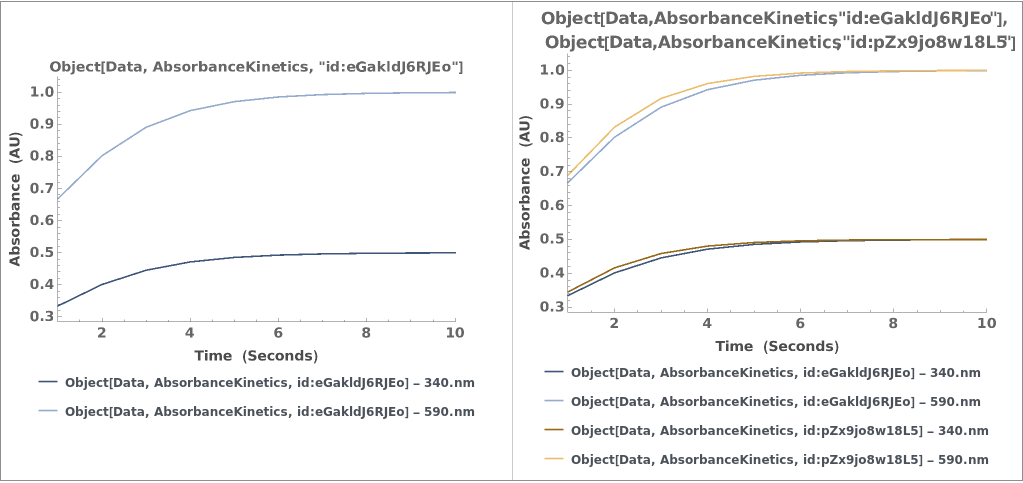
If three-dimensional data is obtained, multiple PlotTypes are possible. Consider using PlotType -> ListPlot3D or ContourPlot.
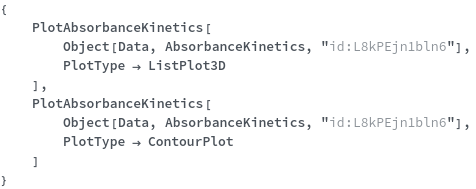

If three-dimensional data is obtained but the traces of specific wavelengths are desired, specify the Wavelength option and set PlotType -> ListLinePlot.

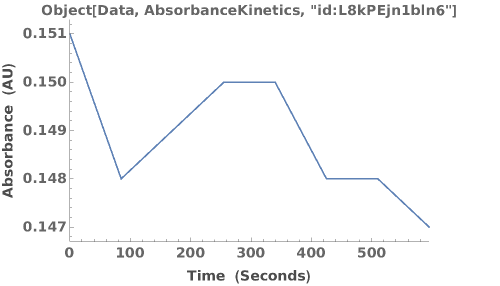
Warnings and Errors
Messages (38)
AbsorbanceKineticsTooManySamples (1)
AbsorbanceSamplingCombinationUnavailable (1)
AliquotRequired (1)
BlankAliquotRequired (1)
BlanksContainSamplesIn (1)
CoveredInjections (1)
DuplicateName (1)
IncompatibleBlankOptions (3)
InjectionSampleStateError (1)
InsufficientBlankSpace (2)
Gives a warning if samples needs to be aliquoted because there's not enough room in the assay container. Note that by specifying a constant value for the blank volume, it becomes possible to avoid the aliquot:



Prints a message and returns $Failed if Aliquot->False and samples need to be aliquoted because there's not enough room in the assay container:




InvalidBlankContainer (1)
InvalidSimultaneousInjections (1)
MixingParametersConflict (1)
MixingParametersRequired (1)
MixingParametersUnneeded (1)
MultipleWavelengthsUnsupported (1)
NotEqualBlankVolumesWarning (1)
RepeatedPlateReaderSamples (2)
ReplicateAliquotsRequired (2)
SamplingPatternMismatch (1)
SinglePlateRequired (2)
SpanWavelengthOrder (1)
TooManyWavelength (1)
UnnecessaryBlankTransfer (1)
Possible Issues
Last modified on Mon 19 Dec 2022 11:22:07






















































































